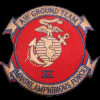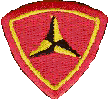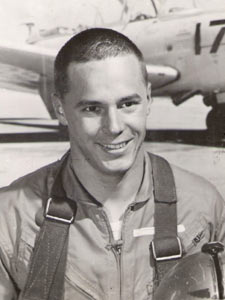Lester Arthur WesighanCorporalHQ CO, HQ BN, 3RD MARDIV, 3RD MAF United States Marine Corps 22 April 1941 - 04 March 1966 New York, New York Panel 05E Line 111 |
 
|
 
|
The database page for Lester Arthur Wesighan
|
Lester was optimistic and had a very cheerful disposition. He had so many hopes and aspirations for his future. His plan was to work at his hometown newspaper and eventually land a position at the Washington Post or New York Times. The editor of his hometown newspaper had received several letters from Okinawa and Vietnam sent by Lester inquiring about the possibility of employment. The editor sent Lester a letter telling him that he was eminently qualified by experience and training for a position in the editorial department. Lester volunteered to go to Vietnam and died fighting for a cause in which he believed. Although I really did not want him to go, I was proud of him. While his unit was engaged in a fierce battle, he left a position of safety and ran to aid a wounded fellow Marine. He received a bullet wound to the head and died instantly. I attended his funeral in Franklin, New Jersey, with his mother and afterwards we drove to Arlington National Cemetery for his military burial service. I can not describe the profound sadness we felt. I loved him and have often fondly thought of him over the years.
From his fiancee, |
|
The last time I saw Lester was just before he was shipped over to Vietnam. I was working for the Navy Department in Washington, D.C. and one night, out of the blue, there was a knock on my apartment door. What a surprise to see my brother, Lester, and a friend. They were broke and needed to borrow money for gas to get them back to Cherry Point. All I had was a $20.00 bill. He promised he'd pay me back, but that chance never came. I still have all the letters he wrote me and miss and love him very much. I was the first one to know he was killed . When I saw those 2 Marines getting out of the car, I knew what they were there for. It happened two days before my own husband, Bob, was shipped to Vietnam. Luckily, he made it back alive. Hope to hear from some friends who knew him. He was so funny and we had a lot of fun together.
From his sister, |
|
"These windswept roads my feet must follow, Unknowingly, Lester wrote his own epitath. Anyone who thought they knew him would not believe that these were his own written words. Anyone who knew him would know that it was not the "best". One of the "best" is gone. I, for one, will always remember the values by which he lived and expressed his life regardless of the outcome. We have one thing to give - love. Lester, I will always love you. Thank you.
Your sister
Nancy Wesighan Pipher |
|
Lester Arthur Wesighan joins the ranks of Arthur Wesighan who died in WWI while a member of the Armed Forces and my cousin Arthur Galvin who died in the Battle of the Bulge in WWII. He is to be remembered, not only as a Marine but also for his dedicated work as a volunteer, doing social work for the poor and minority groups before joining the Marines. His aspirations tended towards helping those who wanted a better life for their children and making the American dream come true. His demise was a loss for the people who so badly needed his support and guidance. Attending his burial at Arlington National Cemetery was one of the saddest days of my life and I hope that those who knew him will carry on towards the goals he cared so much about.
From his uncle, |
|
My name is Melanie Wesighan - my father is Philip Wesighan. Though I never met Lester I have heard many stories about him through my father. My father truly loved him and I could tell that they wre close. I would like to say that I am very proud to be related to Lester.
Love from from your niece, |
|
Lester Wesighan was the first Marine Corps combat correspondent to die in Vietnam. I met Lester in Pensacola in October 1963 in naval aviation Pre-Flight Class 37-63 Bravo. Les and I marched to the cadence of our drill instructor, Marine Staff Sergeant Mikitis (Panel 35 East, Line 48). One of our Navy classmates, Dave Wheat, was later shot down in his F-4 Phantom in October 1965 and spent more than seven brutal years as a prisoner of war. I didn't see Lester again until December 1965 at Da Nang Air Base after he had voluntarily dropped from the flight program to become a combat correspondent. Although Russian rockets were flying into Da Nang that day, Lester was all smiles and glad to see someone from happier days. In that same month, Columbia Broadcast System newsman Walter Cronkite flew a combat mission with an Air Force B57 squadron at Da Nang located next to our Navy F8s. Mr. Cronkite had previously flown in a costly B17 mission over Germany during World War II. Three months later near Chu Lai when he and his photographer, Ken Henderson, were covering Operation Utah, Lester left his cover to crawl through the grass to recover William Brown who had been wounded. As AK47 rounds cut through the grass, Lester signaled for a Navy hospital corpsman but instead fell to a sniper round. There were no corpsmen available because three had already died and the remaining three had been wounded. Ken Henderson then crawled through the grass to recover Lester. After Ken determined William Brown and Les were no longer alive, Ken himself became pinned down by small arms fire. He dug a depression into the ground to avoid enemy rounds. After several hours surrounded by the enemy, Ken was able to crawl back to Marine lines after dark. About 25 years later, Walter Cronkite came to San Diego for a book signing. I told him that we had flown from the eastern end of the runway at Da Nang in 1965. Mr. Cronkite sincerely and graciously said, "I'm so glad you came home." I hope Les Wesighan, William Brown, and the Marines of Operation Utah were able to hear Mr. Cronkite's welcome. In October 2005 Lester's sisters Nancy and Sandi, Ken Henderson, Pat Kessler, Preflight classmates, and members of the Marine Corps Combat Correspondents Association came to my backyard barbecue to honor Lester. As you pass Panel 5 East, please pause at Line 111 to honor Lester Wesighan and the Marines who protected us then and who protect us now.
With respect,
From The Virtual Wall: |
A Note from The Virtual WallOperation UTAH involved the 3rd Battalion, 1st Marines; the 2nd Battalion, 7th Marines; and elements of the ARVN Airborne Battalion. These units were tasked with locating, fixing, and destroying two reinforced battalions of the 36th NVA Regiment dug in around the Chau Ngai village complex about 6 miles northwest of Quang Ngai City in Quang Ngai Province. D-Day for Op Utah was 04 March 1966.On that date the ARVN Airborne Battalion elements led the way into several landing zones near Chau Ngai, followed by the 2/7 Marines. The Marines almost immediately found themselves engaging entrenched NVA troops in what rapidly became a bitter close-quarter fight. The last significant fighting was at 2145; by the next morning the enemy had withdrawn from the area, leaving over 140 NVA/VC bodies on the battlefield. That was unusual; the NVA/VC were normally meticulous in taking their dead with them whenever possible. The 2/7 Command Chronology states the 2/7 Marines lost 43 men killed in action and 84 wounded in action on 04 March 1966. Corporal Wesighan was killed in action during the 2/7 fight at Chau Ngai, making the total US loss 44 men - 41 Marines and 3 Navy Corpsmen. On 05 March the withdrawing NVA forces encountered the 3rd Battalion, 1st Marines, which had established blocking positions astride the NVA's probable withdrawal routes. That too became an exceedingly bitter fight, with 42 Marines and sailors from 3/1 killed in action. |
|
Top of Page
www.VirtualWall.org Back to |
With all respect
Jim Schueckler, former CW2, US Army
Ken Davis, Commander, United States Navy (Ret)
Memorial first published on 8 May 2005
Last updated 08/10/2009